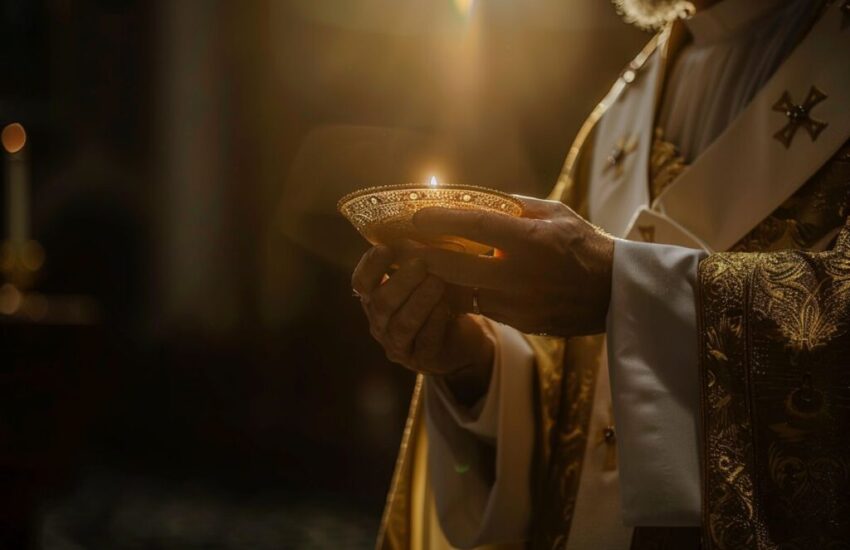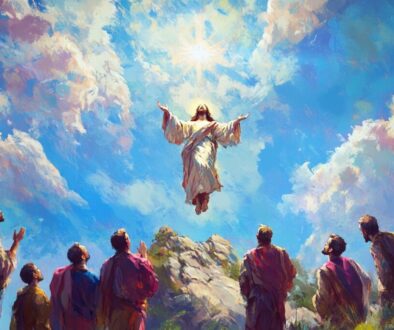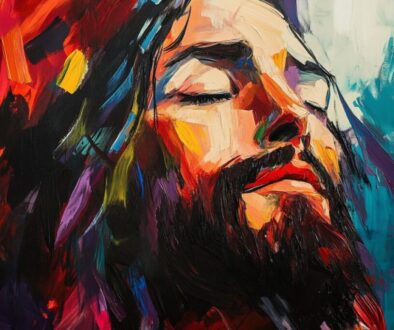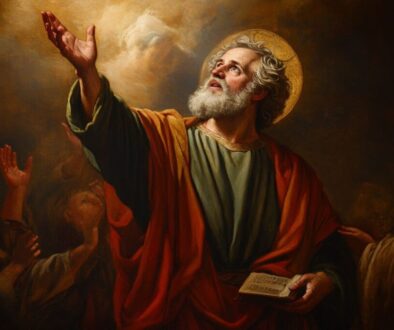The Blood of The Covenant – Corpus Christi – Sermon by Father Levine

Fr. Joseph Levine; Holy Family Catholic Church and Misssions, Burns, Oregon; June 2, 2024
The ranchers among you can be grateful that you are not required to set aside your prize yearling bulls to offer in sacrifice to God; I can be grateful too because in ancient times the priesthood involved some heavy-duty manual labor. Now, in place of all the bulls, rams, and goats of antiquity, we have been given the living Lamb of God, the Lamb who was slain, Jesus Christ, the Lamb who takes away the sins of the world, as the sacrifice by which we offer to God worthy worship. (cf. Jn 1:29; Rev 5:6,12) Having died once and having risen from the dead he is now our unbloody sacrifice.
Before undergoing his Passion and Death, Jesus said, When I am lifted up above the earth I will draw all things to myself. (Jn 12:32) The ‘lifting up’ of Jesus Christ took place through his Crucifixion. The Cross of Christ, the center of all human history.
As a consequence, the ritual sacrifices of the Old Testament, from the time of Abel to the time of Jesus, prefigured Jesus’ own sacrifice on the Cross. While all the legitimate ritual sacrifices since the time of Jesus, that is the celebrations of the Holy Sacrifice of the Mass, re-present his sacrifice on the Cross. All these ritual sacrifices bind every time and place together; they draw all who will to the Cross of Christ, and through his Cross to the Heart of God.
Today we celebrate the Solemnity of the Most Holy Body and Blood of Christ. Before the reform of the liturgy, it was just the solemnity of the Body of Christ and the focus was on the real presence of Christ, his Body, in the Holy Eucharist. There used to be a separate celebration of the Precious Blood of Christ on July 1. Now the two celebrations have been combined and this year the readings bring in focus more the Blood of Christ. This will lead us more to a consideration of the Blood of Christ, offered in the sacrifice of the Mass. Yet, we should always remember that the living Body of Christ in the Eucharist, even in its enduring presence in the tabernacle, even in the monstrance, is always the Body that was offered in sacrifice for our salvation, the Lamb who was slain.
The focus on the Blood of Christ leads us to consider Jesus’ sacrifice on the Cross, through which he expiates our sins and establishes the new and eternal covenant in his own Blood.
At the Last Supper, following the words of the Gospel we heard today, Jesus set forth the chalice saying, This is my blood of the covenant, which will be shed for many. The Letter to the Hebrews tells us that Jesus offered this Blood in the Holy Spirit to cleanse our consciences from dead works to worship the living God. The living God is worshiped by living works that flow forth from the acts of faith, hope, and charity, which are rooted in the life of grace. The interior acts of faith, hope, and charity should be the interior fire that motivates all we think, do, and say.
By offering his own Blood, Jesus is priest, victim, and mediator of the covenant.
We can gain some understanding of what all this means by meditating on today’s 1st reading. There we find Moses serving as the mediator of the Old Covenant. He comes down from the mountain bringing the words of God to the people. If we consider this scene well, he is like the ambassador who returns from a conference with the conquering king, bringing terms of surrender that the king proposes to a rebellious people. God, the king, is a merciful king, who through the terms of the covenant, restores the people to his friendship. (cf. Lk 14:31-32)
The people accept the terms and the following day the covenant is solemnly ratified. Solemnity is something we add to our words and deeds to show our seriousness, to show that we really mean it. Even in a covenant between human parties, sacrifice offered to God had always been the most solemn form of ratification of the covenant, much more when God himself is a party to the covenant.
So, Moses, acting as mediator, offers sacrifice and the details here are full of meaning. First of all, he splashed the blood of the sacrifice on the altar, which represents the side of God. The bloody altar prefigures the Cross of Christ, it is a symbolic prophecy of the crucifixion, when the Son of God made man pours out his Blood as an expiatory sacrifice for our sins. Then in the presence of the bloody altar, in the light of Christ crucified, the people renew their acceptance of the terms of the covenant, they surrender themselves to God and become his people. Their belonging to God as his people is then signified when Moses also splashes the people with the blood. The Blood of Christ, offered in sacrifice, unites God and his people.
The Old Covenant was actually established by God in view of Christ’s future death on the Cross, in view of the shedding of his Blood. That was more than 3,000 years ago.
Now, 2,000 years after Christ died on the Cross, we have the Mass. It is no mere symbol, nor a prophecy, because Christ has already shed his blood for the forgiveness of sins. Now we have the very Blood of Christ to offer anew, in unbloody fashion, on the altar in a solemn renewal of the covenant. That is the holy sacrifice of the Mass.
Nevertheless, before someone can truly participate in the Mass he must belong to the covenant, he must be baptized; that is one reason why in the ancient Church the catechumens were dismissed from the assembly before the liturgy of the Eucharist.
The new and eternal covenant was established when Christ died on the Cross. Nevertheless, individually we enter into that covenant through our baptism. The pattern established in the Mosaic covenant is found also in the rite of baptism. Before we were washed in the baptismal waters, which receive their power to forgive sins from the Blood of Christ, we made (or our parents and godparents made on our behalf) our baptismal vows. This was effectively a way of saying, We will do everything the Lord has told us. It was our acceptance of the terms of the covenant, our unconditional surrender to God; for his part, in his mercy, he grants us his peace, his friendship, the life of grace, his own life, making us thereby to become truly children of God.
Baptisms necessarily take place one at a time. In the Mass, the new people of God, the Church solemnly renews the covenant. The Mass is always an act of the whole Church, even if celebrated privately only by the priest. In the Mass, the mediator is Christ himself, represented by his priest. Before the Blood is offered on the altar, we hear the Gospel proclaimed and we profess our faith. Through that profession of faith in the Holy Trinity, which corresponds to the second part of the baptismal vows – the first part being the renunciation of Satan and his works, above all sin – we effectively submit ourselves anew, unconditionally, to the Lordship of Jesus Christ. Then the covenant is ratified by the offering of the Blood on the altar and our participation in the covenant is brought to completion in holy communion.
Because Jesus is alive, having risen from the dead, and is seated at the right hand of the Father, his Body, Blood, Soul, and Divinity of Jesus Christ are inseparable. His death is represented and offered by the separate consecration of the Body and Blood. Yet, because they are inseparable, it is enough to receive communion under one form; it is always communion with the whole Christ. Indeed, it is not just communion with Christ, the head, but communion also with his members, which implies a pledge to love one another as Christ has loved us. (cf. Jn 13:34)
At the Last Supper Jesus commanded his Apostles, Do this in memory of me. The Mass must be repeated not only because of Christ’s command, not only because the power of Christ’s Blood needs to be made present in every time and place, but also because we need to have the memory of his covenant impressed ever more deeply in our hearts.
What Christ commanded, must be done repeatedly in the midst of the greatest solemnity, such as we are able to provide. Jesus told his disciples, when he sent them to prepare the Passover, that they would be shown a large upper room, furnished and ready.
The words are few and simple, but they an extremely important. We have become used to presentations of the Last Supper as though it were some rustic celebration with earthenware vessels. It seems obvious, because we know that Jesus led a life of poverty. Jesus had said of himself, Foxes have holes, and the birds of the air nests: but the son of man has nowhere to lay his head. (Mt 8:20) Yes, Jesus lived a life of poverty, but he had rich friends. Only a rich man would have had a large, furnished upper room in Jerusalem. That rich friend provided Jesus with everything he and his disciples needed for the celebration of a worthy Passover meal; that would have most likely included four precious silver or gold ceremonial cups, such as the Jews would use on that occasion. He would have provided only the best.
The great follower of Jesus’ poverty, St. Francis of Assisi, also took great care to seek out worthy chalices of gold or silver for use in the Mass.
For our part, we should provide the best we have to give both exteriorly and interiorly. Because we are made of body and soul, to be nourished by the Body and Blood of Christ, the exterior without the interior is vain; the interior without the exterior is a deceptive illusion. We should above all offer to Jesus our own heart as a large room, clean of sin, ready, and furnished with the virtues that are pleasing to him. We should prepare for and bring to the Mass the best we have to give, body and soul; then after we have offered our very selves to God, with all the best that we have, we should go forth, mindful that we have been consecrated to God, that we belong to God, through Jesus Christ, in the new and eternal covenant in his Blood. We should then live in the world not as belonging to the world, but as belonging to Christ.
You should know that you have been redeemed from the futile manner of life received from your forefathers not by corruptible gold or silver, but by the precious Blood of Christ, as it were, of a lamb without spot or blemish. (1 Pe 1:18-19)
Seek a Deeper Connection with God and Join Lay Cistercians of South Florida
Lay Cistercians of South Florida, is a community of lay people who seeks to have a deeper connection with God by living a life inspired by the monks and nuns through Lay Monasticism. Learn more about what is a Lay Cistercian on our website. Anyone who aspires to do the same as us, and is a confirmed Catholic is welcome to join us! We meet every second Saturday of the month at Emmanuel Catholic Church in Delray Beach, Florida.

This Content Has Been Reviewed For Accuracy
This content has undergone comprehensive fact-checking by our dedicated team of experts. Discover additional information about the rigorous editorial standards we adhere to on our website.



